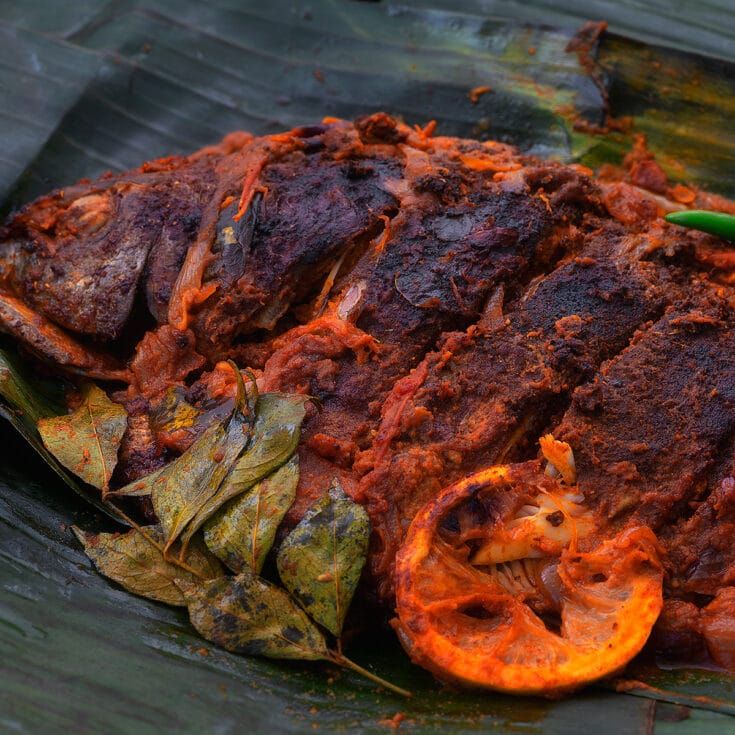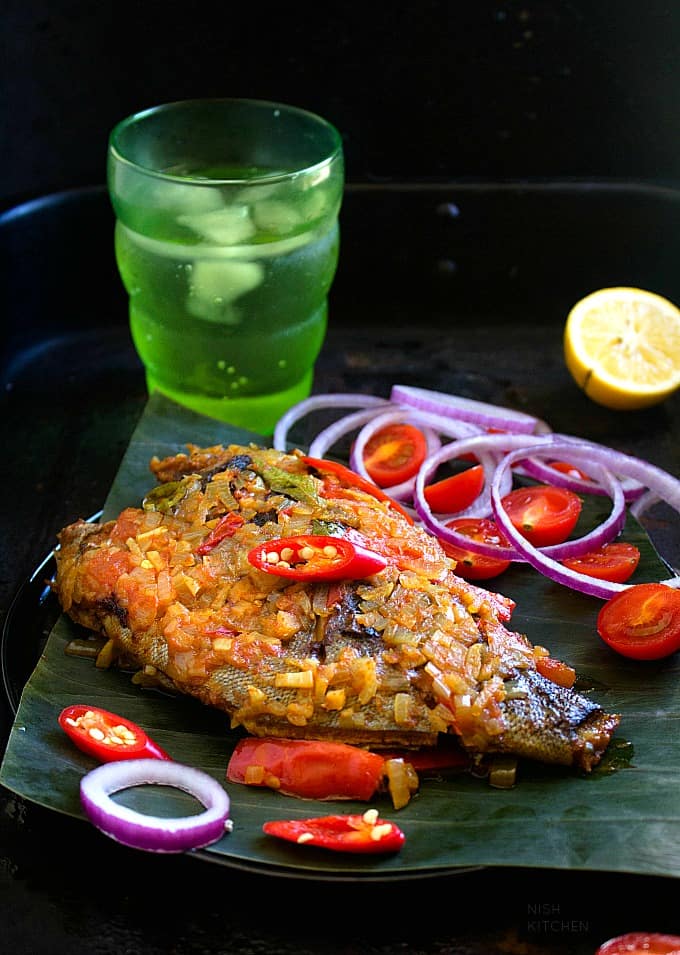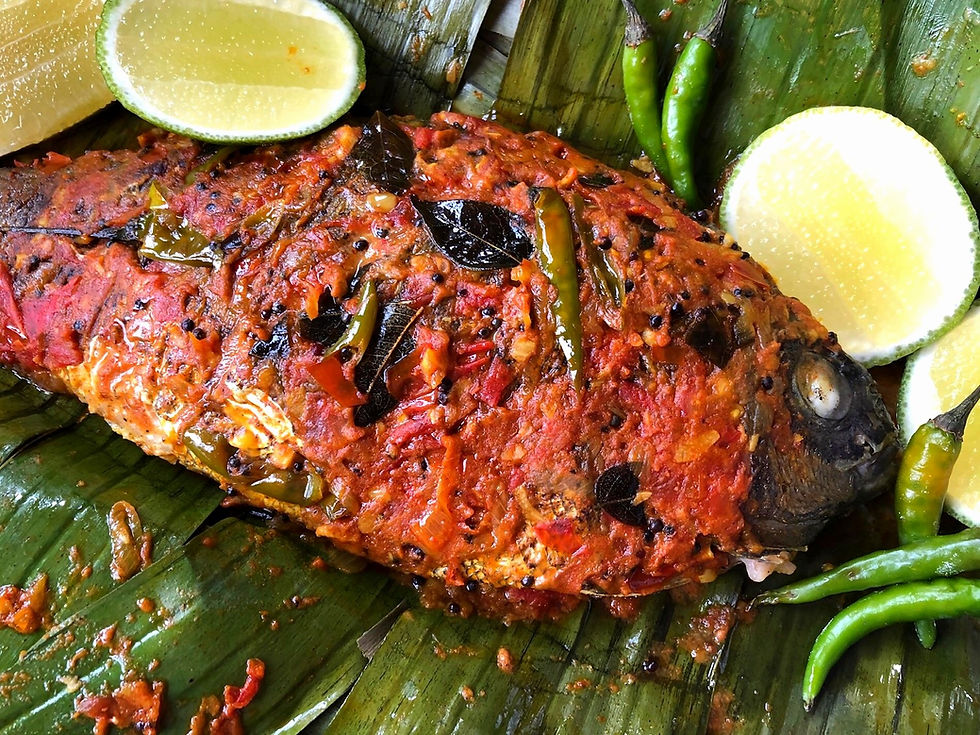Meen Pollichathu is a classic dish from the southwestern Indian state of Kerala, which is renowned for its backwaters, lush landscapes, and a robust spice trade that historically connected it with many parts of the world. The term “Meen” translates to “fish” in Malayalam, the local language, and “Pollichathu” refers to the method of cooking the fish, which is typically “grilled” or “roasted.” However, the unique aspect of this method lies not just in grilling, but in the fish being marinated in a blend of spices, then wrapped in banana leaves and cooked. This method imparts a special aroma and flavour to the fish, which is often a variety like pearl spot (known locally as ‘Karimeen’) or pomfret, although various other kinds of fish can also be used.
The preparation of Meen Pollichathu involves marinating the fish first in a paste that usually contains spices such as turmeric, chili powder, pepper, and salt, along with a dash of lime juice. This marination process allows the spices to permeate the fish and provides a base layer of flavor. After the marination, the fish is shallow fried to a golden hue, which gives it a crispy outer layer. Once fried, the fish is further cooked with a masala usually made with onions, garlic, ginger, tomatoes, and sometimes additional spices and condiments specific to regional or family recipes. The fish, along with this masala, is then wrapped in banana leaves which have been softened by a brief exposure to flame, securing the edges with a toothpick or string to keep it all intact.
Meen Pollichathu Recipe


Meen Pollichathu
Equipment
- 1 small bowl
- 1 large pan
Ingredients
FOR THE FISH
- 1 teaspoon red chile powder
- 1/2 teaspoon ground coriander
- 1/2 teaspoon salt
- 1/2 teaspoon freshly ground black pepper
- 1/2 teaspoon ground turmeric
- 4 4- to-6-ounce fish fillets, such as tilapia, cod, or pomfret
- 1 tablespoon coconut oil
FOR THE MASALA
- 1 tablespoon coconut oil
- 2 onions chopped
- 2 curry leaf sprigs
- 3 garlic cloves minced
- 1 1-inch piece fresh ginger, peeled and minced
- 2 tomatoes chopped
- 1 green chile minced
- 1 teaspoon red chile powder
- 1 teaspoon ground coriander
- 1/2 teaspoon ground turmeric
- Salt
- 2 tablespoons shredded fresh coconut or frozen, thawed to room temperature
- 2 cilantro sprigs roughly chopped
FOR PREPARING
- 1 banana leaf about 36 inches long, cut into 4 pieces
- Coconut oil for greasing
- 1 curry leaf sprig
- Vegetable or corn oil for cooking
- 2 limes cut into wedges
Instructions
TO MAKE THE FISH
- In a small bowl, stir together the chile powder, coriander, salt, pepper, and turmeric. Spread this spice blend over both sides of each fish fillet. Let rest for 10 minutes.
- In a large pan over medium heat, heat the coconut oil. Add the fillets and fry for 2 to 3 minutes per side, until lightly browned and nearly cooked through. Transfer the fish to a plate and set aside.
TO MAKE THE MASALA
- In the same pan over medium-high heat, heat the coconut oil. Add the onions, curry leaves, garlic, and ginger. Cook for 5 to 7 minutes, until the onions are translucent.
- Stir in the tomatoes, green chile, chile powder, coriander, and turmeric and season with salt. Cook for 3 to 5 minutes, stirring frequently, until the tomatoes are softened and broken down.
- Add the coconut and cilantro and cook for 2 minutes more.
- Add the cooked fish to the masala. Spoon the masala over thefish and gently stir the sauce
- to prevent scorching, being careful not to break apart the fillets.
TO PREPARE THE DISH
- Heat a banana leaf piece over one of your stove’s burners to soften it until it bends easily. Lightly grease the leaf on one side with coconut oil.
- Sprinkle some of the curry leaves over the banana leaf. Add some of the masala to the banana leaf, then place one of the fish fillets on it. Cover the fillet with more masala so both sides of the fish are coated. Repeat with the remaining banana leaves and fish.
- Wrap two opposite sides of the banana leaf inward, over the fish, and then wrap the other two sides inward to close the package. Tie the leaf shut using kitchen twine. Repeat with there maining banana leaves.
- In a large skillet over low heat, heat 1 tablespoon of vegetable oil. Place the banana leaf wrapped fish in the skillet. Cover and cook for 5 minutes. Flip and cook on the other side for 5 minutes.
- Transfer to a plate and unwrap the fish at the table. Serve with lime wedges for squeezing.
Notes
instead. The fish can also be served family style, wrapping the fillets in one large banana leaf (or foil piece) before cooking.
Cooking tips about Meen Pollichathu

- Selecting the Fish: The traditional choice is pearl spot (‘Karimeen’) or pomfret because they are local to the Kerala region and their texture complements this cooking method well. Make sure the fish is fresh to get the best flavor.
- Marination Time: Allow the fish to marinate for at least 30 minutes, so it absorbs the spices thoroughly. If you have time, letting it marinate for a couple of hours in the refrigerator could enhance the taste further.
- Frying the Fish: When shallow frying the marinated fish, ensure the oil is hot enough so that the fish becomes crispy quickly without absorbing too much oil.
- Preparing the Banana Leaves: Banana leaves should be cleaned and gently passed over a flame to make them pliable. This prevents them from tearing when wrapping the fish and also releases their aromatic oils, which adds to the flavor.
- Masala Mix: Sauté onions, garlic, ginger, and tomatoes until they are soft and the raw smell disappears. Make sure that the masala is rich and thick, so it sticks to the fish during the cooking process.
- Wrap Securely: After placing the fish with its masala onto the banana leaf, wrap it securely so that none of the contents spill out. This ensures that all flavors are sealed inside during the cooking process.
- Low Flame Cooking: Cook the wrapped fish on a low flame. Slow cooking helps in infusing the flavors deeply into the fish from the banana leaf and masala.
- Patience is Key: Don’t hurry the process. It typically takes around 15 to 20 minutes per side to cook the fish perfectly, but it might vary depending on the size and thickness of the fish pieces.
- Resting Time: After cooking, let the fish rest for a few minutes before opening the banana leaves; this allows the flavors to settle.
- Serving: Serve Meen Pollichathu hot, as it is best enjoyed fresh off the stove. It can be paired with a plate of steaming rice or tapioca, which are traditional accompaniments in Kerala.
Serving suggestions about Meen Pollichathu

Steamed rice works well because it has a mild flavor that complements the rich spiciness of the fish, letting the taste of the marinated and banana leaf-wrapped fish shine. The boiled tapioca, slightly crushed and mixed with coconut oil, salt, and sometimes a hint of garlic, is another staple in Kerala and balances out the flavors of Meen Pollichathu with its starchy texture and subtle taste.
You might also want to serve a simple side of stir-fried vegetables, such as beans or okra, seasoned with mustard seeds, curry leaves, and grated coconut to add some greens to the meal. Don’t forget the traditional ‘pappadam’, which is a crispy lentil cracker that goes really well with such dishes.
A tangy, spicy ‘kachumber’ salad — typically chopped cucumber, onion, green chilies, and tomatoes mixed with vinegar or lemon juice and a pinch of salt — can be a refreshing side that cuts through the richness of the fish.
For a beverage, a cold glass of buttermilk seasoned with curry leaves and a pinch of salt would be a perfect traditional pairing. Alternatively, warm black tea can also be served to complement the meal.
Lastly, the setting matters too! If possible, serving the fish still wrapped in the banana leaf adds to the authenticity and creates an aromatic and visual delight for your guests or family, enhancing their culinary experience.
Top 5 FAQs about Meen Pollichathu

- What kind of fish is best for Meen Pollichathu?
The ideal choices are pearl spot, known locally as ‘Karimeen’, or pomfret because of their texture and flavor, which pair well with the spices and cooking method used in Meen Pollichathu. However, other firm-fleshed fish can also be used. - How long should the fish marinate before cooking?
It is recommended to let the fish marinate for at least 30 minutes to allow it to soak up the flavors of the spices. For an even richer taste, marinating the fish for a couple of hours, preferably in the refrigerator, is suggested. - Why is the fish wrapped in banana leaves for cooking?
Wrapping the fish in banana leaves helps to infuse it with a distinct aroma and ensures that the fish retains its moisture while the spices merge together within the enclosed packet. The banana leaves also contribute their own subtle flavor to the dish. - Can Meen Pollichathu be made without frying the fish?
Frying the fish is part of the traditional method to give it a crispy exterior. However, variations may omit frying if preferred. Keep in mind that frying adds texture and helps seal the flavors before the fish is wrapped and cooked in the banana leaf. - What are some traditional side dishes to serve with Meen Pollichathu?
Steamed rice and boiled tapioca are the most common and traditional accompaniments. You can also include stir-fried vegetables seasoned with mustard seeds and grated coconut, crispy lentil crackers known as ‘pappadam’, and a tangy ‘kachumber’ salad as sides. To drink, seasoned buttermilk or warm black tea complements the meal well.
In conclusion, Meen Pollichathu is a cherished dish from Kerala that captures the essence of the region’s culinary traditions. This delicacy stands out for its method of cooking, where marinated fish is wrapped in banana leaves and cooked to perfection, allowing for a symphony of flavors to be steamed into the fish, creating a moist and aromatic meal. The spices used are reflective of Kerala’s rich history in the spice trade, bringing turmeric, chili, pepper, and more to the forefront of this beloved recipe.

Leave a Reply